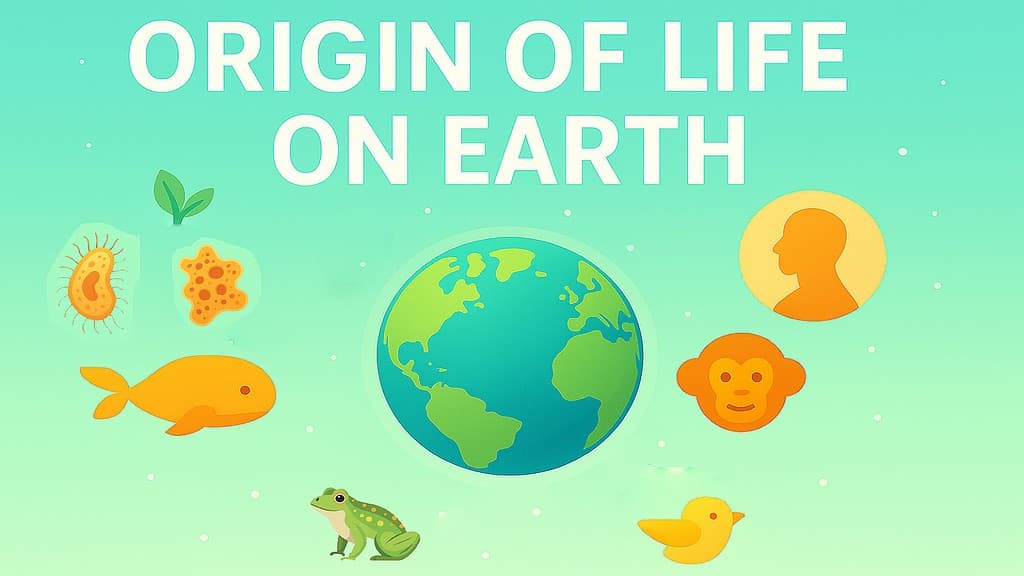Table of Contents
Introduction: Origin of Life and Humanity’s Greatest Mystery
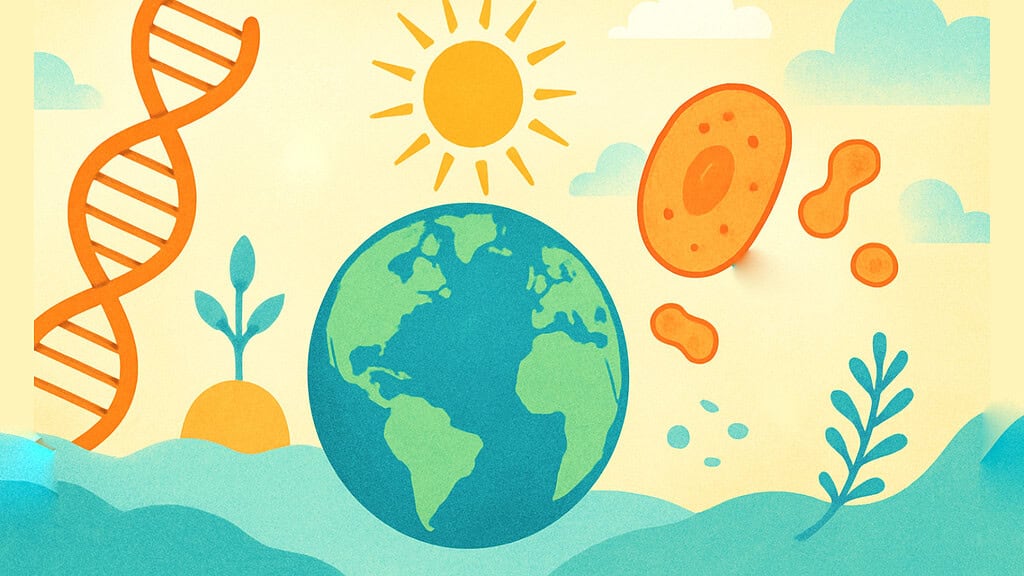
The origin of life remains one of the most intriguing mysteries in science. For centuries, humanity has pondered how the initial spark of existence arose from inanimate matter on Earth. This fundamental question drives researchers across multiple disciplines, from chemistry to astronomy, as they search for clues about how simple molecules transformed into the complex systems we call life.
Scientists estimate that life began roughly 3.8 billion years ago, yet the exact mechanisms remain shrouded in mystery. The transition from non-living chemistry to living biology represents a monumental leap that challenges our understanding of natural processes. Each theory of the origin of life we explore offers a different lens through which to view this remarkable transformation.
Understanding the origin of life carries profound implications beyond mere scientific curiosity. These investigations help us recognize life’s potential on other worlds, guide our search for extraterrestrial organisms, and deepen our appreciation for the remarkable chain of events that led to our existence. The theories of the origin of life reveal how diverse environmental conditions might have contributed to life’s emergence.
Key Challenges in Origin of Life Research
| Challenges | Description | Current Status |
|---|---|---|
| Complexity Gap | Bridging the gap between simple molecules and living cells | Multiple theories proposed |
| Timeline Uncertainty | Determining when life first appeared | Evidence suggests 3.8-4.1 billion years ago |
| Environmental Conditions | Reconstructing early Earth’s atmosphere and oceans | Ongoing geological research |
| Molecular Self-Organization | Understanding how molecules organize spontaneously | Laboratory experiments continue |
| Information Storage | Explaining the origin of genetic codes | RNA World hypothesis leading candidate |
1. Origin of Life: The Primordial Soup Theory
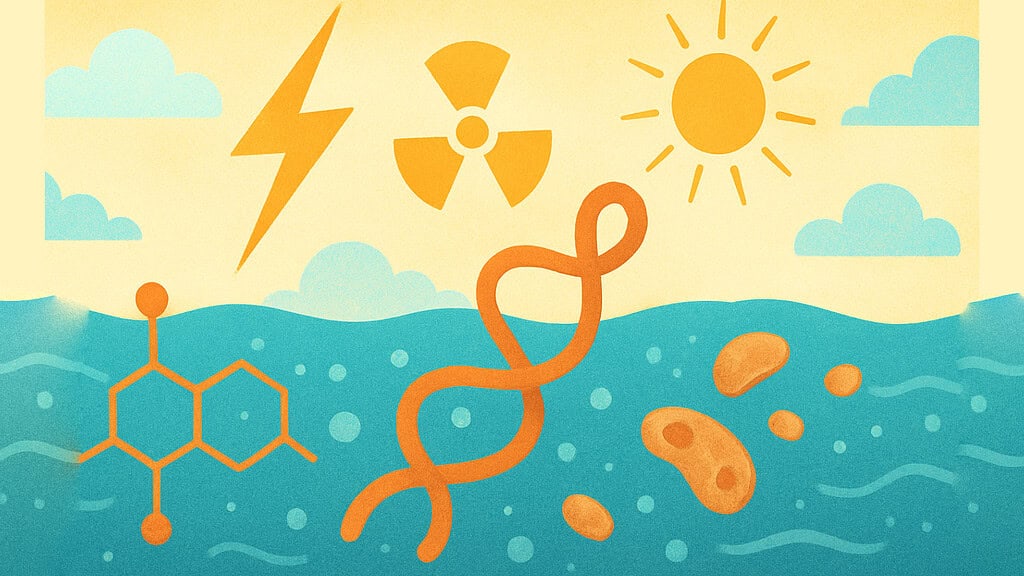
The primordial soup theory paints early Earth as a vast chemical laboratory. This hypothesis suggests that life’s building blocks formed in ancient oceans through natural chemical processes. Lightning strikes and ultraviolet radiation provided the energy needed to transform simple atmospheric gases into complex organic molecules.
Alexander Oparin first proposed this concept in the 1920s, imagining Earth’s early atmosphere as a reducing environment rich in methane, ammonia, hydrogen, and water vapor. Without oxygen to interfere, these conditions allowed complex chemistry to flourish in ways impossible on modern Earth.
The famous Miller-Urey experiment in 1953 brought this theory from speculation to scientific testing. Stanley Miller and Harold Urey recreated what they believed were early Earth conditions in a glass apparatus. They filled flasks with methane, ammonia, hydrogen, and water, then subjected the mixture to electrical sparks simulating lightning. Within days, their experiment produced amino acids, the building blocks of proteins.
This groundbreaking work demonstrated that organic molecules could indeed form spontaneously under the right conditions. The experiment yielded glycine, alanine, and other amino acids essential to life. Later variations of the experiment produced even more complex molecules, including nucleotide bases that form DNA and RNA.
Modern research has refined our understanding of early Earth’s atmosphere, suggesting it may have contained more carbon dioxide and nitrogen than originally thought. Despite these revisions, the core principle remains valid: energy sources like lightning could have driven the formation of life’s molecular components in Earth’s ancient waters.
Miller-Urey Experiment Results and Implications For the Origin of Life
| Component | Result | Significance for Origin of Life |
|---|---|---|
| Amino Acids | 20+ types produced | Building blocks of proteins formed spontaneously |
| Organic Acids | Formic, acetic, lactic acids | Metabolic pathway precursors |
| Sugars | Simple carbohydrates | Energy storage molecules |
| Nucleotide Bases | Adenine, guanine components | DNA/RNA building blocks |
| Time Frame | Days to weeks | Relatively rapid formation |
2. Origin of Life: The RNA World Hypothesis
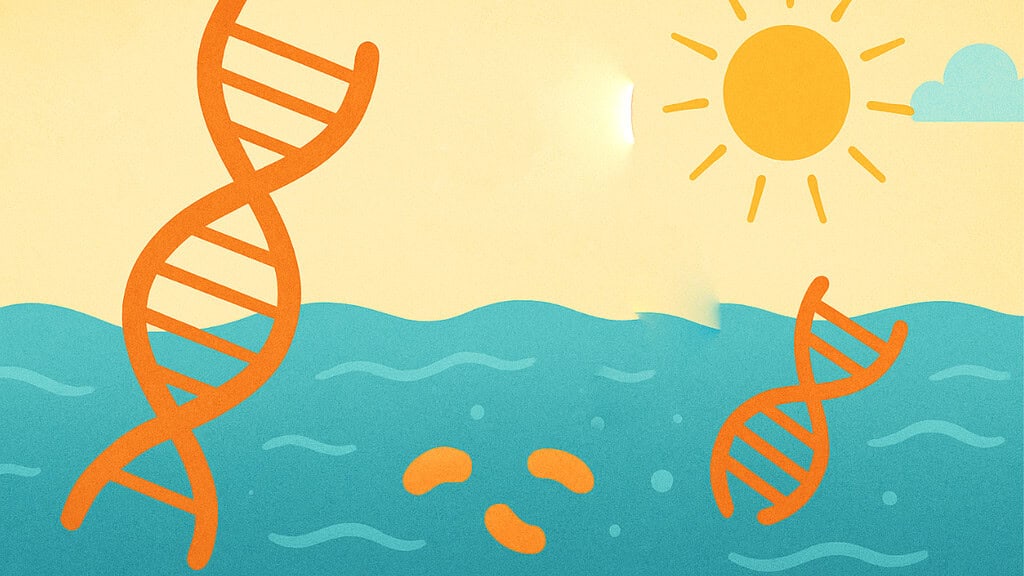
The RNA World hypothesis addresses one of the most puzzling aspects of life’s origin: the chicken-and-egg problem of information storage and processing. Modern cells require DNA to store information, proteins to catalyze reactions, and RNA to connect these functions. But which came first?
RNA provides a sophisticated solution by functioning in two capacities: as an information carrier and as a catalyst. Unlike DNA, which mainly preserves genetic information, RNA molecules possess the ability to fold into intricate three-dimensional structures that allow them to catalyze chemical reactions. These catalytic RNA entities, known as ribozymes, are capable of facilitating their own replication.
Thomas Cech and Sidney Altman’s discovery of ribozymes in the 1980s revolutionized thinking about early life. They found that certain RNA molecules could cut and splice themselves without protein assistance. This discovery earned them the Nobel Prize and provided crucial evidence that RNA could have preceded both DNA and proteins in evolutionary history.
The RNA World scenario envisions a time when RNA molecules dominated early life. These versatile molecules could store genetic information, catalyze their own replication, and evolve through natural selection. Over time, DNA took over information storage due to its greater stability, while proteins assumed most catalytic functions due to their structural diversity.
Recent research has strengthened the RNA World hypothesis by demonstrating that ribozymes can perform increasingly complex tasks. Scientists have created RNA molecules that can synthesize other RNAs, suggesting that a self-sustaining RNA ecosystem could have existed on early Earth.
RNA vs DNA vs Proteins: Functional Capabilities
| Molecule | Information Storage | Catalytic Activity | Structural Stability | Evolutionary Priority |
|---|---|---|---|---|
| RNA | Moderate | High | Moderate | First (hypothetical) |
| DNA | Excellent | Very Low | High | Second |
| Proteins | None | Excellent | Variable | Third |
| Modern Role | Intermediary | Some (ribozymes) | Support | Information transfer |
3. Origin of Life: The Hydrothermal Vent Hypothesis

Deep beneath ocean waves, where sunlight never reaches, hydrothermal vents create oases of chemical activity. These underwater geysers spew superheated water rich in minerals and gases, creating conditions that many scientists believe could have nurtured the first life forms. The hydrothermal vent hypothesis suggests these extreme environments provided the energy and chemistry needed for life’s emergence.
Hydrothermal vents are created when seawater interacts with magma via fissures in the oceanic crust. This interaction produces a chemical mixture that includes hydrogen sulfide, methane, carbon dioxide, and a range of metals. Temperature gradients create natural convection currents that concentrate and mix these chemicals in ways that could promote complex reactions.
The discovery of thriving ecosystems around modern hydrothermal vents supports this theory. These communities exist entirely without sunlight, deriving energy from chemical processes rather than photosynthesis. Bacteria near the vents use chemosynthesis to convert inorganic chemicals into organic compounds, demonstrating that life can flourish in such extreme conditions.
Alkaline hydrothermal vents, particularly those at Lost City in the Atlantic Ocean, have garnered special attention. These vents produce conditions similar to those inside living cells, with natural pH gradients that could drive the formation of complex molecules. The mineral structures they create can act as natural catalysts, potentially facilitating the chemical reactions necessary for life.
Laboratory experiments have shown that vent-like conditions can produce organic compounds from simple inorganic materials. These studies demonstrate how the unique chemistry of hydrothermal environments could have bridged the gap between geological processes and biological systems.
Hydrothermal Vent Characteristics Supporting Origin of Life
| Feature | Description | Benefit for Early Life |
|---|---|---|
| Temperature Gradients | Hot vent water meets cold seawater | Drives chemical reactions and molecular concentration |
| Mineral Catalysts | Iron, nickel, sulfur compounds | Accelerate organic molecule formation |
| Chemical Energy | Hydrogen, methane, hydrogen sulfide | Fuel for metabolic processes |
| Protected Environment | Shielded from UV radiation | Allows fragile molecules to persist |
| Continuous Flow | Fresh chemicals constantly supplied | Maintains non-equilibrium conditions |
4. Origin of Life: The Panspermia Theory

The panspermia theory boldly suggests that life’s ingredients, or even life itself, arrived on Earth from outer space. This hypothesis expands the search for life’s origin beyond our planet’s boundaries, proposing that meteorites, comets, or interstellar dust carried the seeds of life across the cosmos.
Evidence supporting panspermia comes from the discovery of organic compounds in meteorites. The Murchison meteorite, which fell in Australia in 1969, contains over 70 amino acids, including several not found in terrestrial life. These findings demonstrate that space environments can produce and preserve complex organic molecules.
Comets also serve as potential delivery vehicles for life’s building blocks. These frigid celestial bodies are composed of water, methane, ammonia, and a range of organic compounds. When comets impact planetary surfaces, they could deliver these materials along with the energy needed to drive chemical reactions.
Recent research has identified potentially habitable exoplanets throughout our galaxy, lending credibility to the idea that life might be widespread in the universe. If life can arise in multiple locations, the transfer of organisms or organic molecules between worlds becomes more plausible.
The theory faces challenges in explaining how living organisms could survive the harsh conditions of space travel, including radiation, extreme temperatures, and the vacuum of space. However, studies have shown that some extremophile bacteria can survive extended periods in space-like conditions, suggesting that interplanetary transfer of life might be possible.
Evidence for Extraterrestrial Organic Compounds
| Source | Organic Compounds Found | Implications |
|---|---|---|
| Murchison Meteorite | 70+ amino acids, nucleobases | Complex chemistry possible in space |
| Comet 67P | Glycine, phosphorus compounds | Comets as delivery vehicles |
| Interstellar Medium | Formaldehyde, methanol, ethanol | Widespread organic chemistry |
| Mars Meteorites | Polycyclic aromatic hydrocarbons | Potential for life on other planets |
| Titan Atmosphere | Complex organic hazes | Alternative biochemistry environments |
5. Origin of Life: The Clay Hypothesis
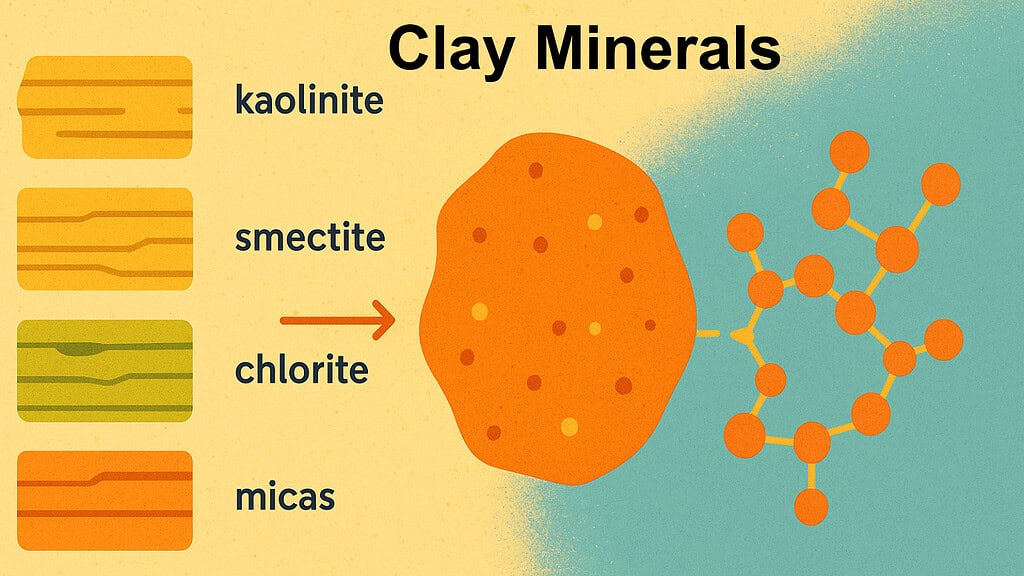
The clay hypothesis presents an intriguing solution to the problem of molecular organization in early life. Proposed by Scottish chemist Graham Cairns-Smith, this theory suggests that clay minerals acted as templates and catalysts, helping simple organic molecules organize into increasingly complex structures capable of replication and evolution.
Clay minerals possess unique properties that make them excellent candidates for supporting early life processes. Their crystalline structure creates regular patterns that can serve as templates for organizing other molecules. Additionally, clays can absorb and concentrate organic compounds from dilute solutions, bringing reactants together in ways that promote chemical interactions.
The hypothesis proposes that clay crystals could replicate their structural information through crystal growth and fragmentation. Variations in crystal structure would be passed on to daughter crystals, creating a primitive form of inheritance. Organic molecules associated with these crystals could gradually take over the replication process, eventually becoming independent of their mineral templates.
Laboratory experiments have demonstrated that clay minerals can indeed catalyze the formation of complex organic molecules. Montmorillonite clay, for example, can promote the formation of RNA-like polymers from simple nucleotides. These studies show that clays can facilitate the types of reactions necessary for life’s emergence.
The clay hypothesis helps explain how the transition from simple chemistry to complex biology might have occurred gradually. Rather than requiring a sudden leap to self-replicating molecules, this theory provides a pathway for increasing complexity through mineral-organic interactions.
Properties of Clay Minerals Supporting Origin of Life
| Property | Description | Role in Origin of Life |
|---|---|---|
| Surface Area | Enormous internal surfaces | Concentrates organic molecules |
| Ion Exchange | Absorbs and releases ions | Provides catalytic metal centers |
| Swelling Ability | Expands when wet | Creates protected spaces for reactions |
| Template Structure | Regular crystal lattices | Guides molecular organization |
| Chemical Stability | Resists breakdown | Provides persistent organizing framework |
6. Origin of Life: The Iron-Sulfur World Hypothesis

The iron-sulfur world hypothesis, advocated by German biochemist Günter Wächtershäuser, suggests that life originated on mineral surfaces abundant in iron and sulfur compounds. This theory suggests that metabolic processes preceded the formation of complex organic molecules, reversing the traditional sequence of life’s development.
Iron-sulfur minerals, particularly pyrite and pyrrhotite, possess catalytic properties that can drive the formation of organic compounds from simple inorganic precursors like carbon dioxide and carbon monoxide. These reactions can occur at moderate temperatures and pressures, making them feasible in various Earth environments during the planet’s early history.
The hypothesis draws inspiration from the iron-sulfur clusters found in many modern enzymes, particularly those involved in fundamental metabolic processes. These ancient molecular fossils suggest that iron-sulfur chemistry played a crucial role in life’s earliest stages. The prevalence of such clusters in core metabolic pathways supports the idea that metabolism emerged before complex genetic systems.
Experimental work has shown that iron-sulfur minerals can indeed catalyze the formation of organic molecules under conditions that might have existed on early Earth. These reactions can produce amino acids, organic acids, and even simple polymers. The continuous supply of chemical energy from mineral reactions could have sustained these processes over extended periods.
This theory offers a different perspective on life’s origin by emphasizing metabolism over replication. Rather than beginning with self-replicating molecules, life might have started as networks of chemical reactions sustained by mineral surfaces. Genetic systems would have evolved later to regulate and optimize these metabolic networks.
Iron-Sulfur Minerals and Their Catalytic Properties
| Mineral | Chemical Formula | Catalytic Function | Modern Biological Parallel |
|---|---|---|---|
| Pyrite | FeS₂ | Carbon fixation | Photosystem I |
| Pyrrhotite | Fe₇S₈ | Hydrogen production | Hydrogenase enzymes |
| Marcasite | FeS₂ | Organic synthesis | Various metabolic enzymes |
| Troilite | FeS | Electron transfer | Ferredoxin proteins |
| Chalcopyrite | CuFeS₂ | Redox reactions | Cytochrome oxidase |
7. Origin of Life: The Electric Spark Theory

The electric spark theory focuses on lightning as a crucial driver of chemical reactions that could have led to life’s emergence. Building on the primordial soup concept, this theory emphasizes the specific role of electrical discharges in transforming simple atmospheric gases into complex organic molecules.
Lightning provides intense energy that can break apart stable molecules and recombine their atoms in new ways. On early Earth, with its different atmospheric composition and more active weather patterns, lightning strikes would have been frequent and powerful. These electrical discharges may have continuously interacted with the atmosphere, progressively increasing the levels of organic compounds.
Modern calculations suggest that lightning on early Earth could have produced significant quantities of organic molecules. The energy from a single lightning bolt can reach temperatures of 30,000 Kelvin, five times hotter than the Sun’s surface. This extreme energy can drive reactions that would be impossible under normal conditions.
The theory gains support from studies of lightning’s effects on various gas mixtures. Experiments have shown that electrical discharges can produce amino acids, nucleotide bases, and other biologically important molecules from simple atmospheric components. The efficiency of these reactions depends on the specific atmospheric composition and the energy of the discharge.
Recent research has expanded the electric spark theory to include other forms of electrical activity, such as coronal discharges and electrical activity in volcanic plumes. These phenomena could have contributed to organic molecule production in diverse environments across early Earth, increasing the chances of life’s emergence.
Role of Electrical Phenomena and Organic Molecule Production in Origin of Life
| Electrical Source | Energy Level | Products Formed | Environmental Context |
|---|---|---|---|
| Lightning Bolts | Very High | Amino acids, HCN, formaldehyde | Atmospheric storms |
| Coronal Discharge | Moderate | Simple organic acids | Near metallic surfaces |
| Volcanic Lightning | High | Complex hydrocarbons | Volcanic eruptions |
| Piezoelectric Effect | Low | Radical formation | Rock fracturing |
| Triboelectric Charging | Low | Ion production | Dust storms, wind |
8. Origin of Life: The Deep-Freeze or Ice Hypothesis

The deep-freeze or ice hypothesis presents a counterintuitive scenario where extremely cold conditions actually promoted life’s emergence. This theory suggests that ice provided the perfect environment for concentrating organic molecules and protecting them from destructive forces while allowing slow, controlled chemical evolution.
Ice formations can create concentrated pockets of chemicals within their crystal structure. As water freezes, dissolved substances become excluded from the ice crystals and concentrate in liquid channels and pockets. This natural concentration effect could have brought reactive molecules together in ways that promoted complex chemistry.
The hypothesis draws support from studies of modern extremophile organisms that thrive in polar environments. These life forms have adapted to survive freezing temperatures, demonstrating that biological processes can continue even in icy conditions. Some researchers propose that similar cold-adapted chemistry could have operated on early Earth.
Snowball Earth periods, when much of the planet was covered in ice, might have provided ideal conditions for this type of chemistry. The ice would have protected fragile organic molecules from ultraviolet radiation while creating the concentrated chemical environments necessary for complex reactions. When the ice eventually melted, it would have released these concentrated solutions into the environment.
Laboratory experiments have shown that certain chemical reactions proceed more efficiently at low temperatures, particularly those involving the formation of complex polymers. The controlled conditions within ice might have allowed for the gradual assembly of increasingly sophisticated molecular systems without the disruptive effects of high temperatures.
Ice Environment Advantages for Origin of Life and Early Life Chemistry
| Ice Feature | Chemical Benefit | Biological Relevance |
|---|---|---|
| Molecular Concentration | Excludes solutes during freezing | Increases reaction rates |
| UV Protection | Blocks harmful radiation | Preserves fragile molecules |
| Temperature Control | Slows destructive reactions | Allows selective chemistry |
| Pressure Effects | Creates unique chemical conditions | Enables otherwise impossible reactions |
| Seasonal Cycling | Freeze-thaw concentration cycles | Repeated molecular organization |
Conclusion: Origin of Life and the Endless Quest for Answers

The eight theories explored in this investigation reveal the rich complexity surrounding life’s emergence on Earth. Each hypothesis offers unique insights into how the transition from chemistry to biology might have occurred, yet none provides a complete answer to this fundamental question. The primordial soup theory demonstrates how energy can drive organic synthesis, while the RNA World hypothesis explains how information storage and catalysis might have emerged simultaneously.
Hydrothermal vents showcase the power of extreme environments to support complex chemistry, while panspermia expands our perspective to cosmic scales. The clay hypothesis illustrates how mineral templates could have guided molecular organization, and the iron-sulfur world theory emphasizes metabolism’s primacy over replication. Electric spark theory highlights energy’s crucial role, while the ice hypothesis shows how seemingly hostile environments might actually nurture life’s beginnings.
These diverse approaches reflect the multifaceted nature of life’s origin. Rather than competing theories, they may represent different aspects of a complex process that unfolded over millions of years. Early Earth likely experienced all of these conditions at various times and locations, suggesting that multiple pathways might have contributed to life’s emergence.
The search for life’s origin continues to drive scientific innovation and discovery. New analytical techniques allow researchers to probe ever deeper into the molecular details of early life, while advances in astronomy reveal the prevalence of potentially habitable worlds throughout the universe. Every discovery contributes an additional element to the understanding of how life originated.
Understanding our origins carries profound implications for humanity’s future. As we search for life beyond Earth and contemplate the possibility of creating artificial life in laboratories, these theories guide our efforts and shape our expectations. They remind us that life’s emergence, while remarkable, followed natural laws and processes that we can understand through careful investigation.
Current Status of Origin of Life Theories
| Theories of Origin Of Life | Supporting Evidence | Remaining Challenges | Research Activity Level |
|---|---|---|---|
| Primordial Soup | Miller-Urey experiments | Atmospheric composition uncertainty | High |
| RNA World | Ribozyme discoveries | RNA stability problems | Very High |
| Hydrothermal Vents | Modern vent ecosystems | Limited ancient geological evidence | High |
| Panspermia | Meteorite organics | Survival in space conditions | Moderate |
| Clay Hypothesis | Mineral catalysis studies | Limited experimental validation | Low |
| Iron-Sulfur World | Metabolic enzyme similarities | Complex reaction network proof | Moderate |
| Electric Spark | Lightning synthesis experiments | Energy efficiency questions | Low |
| Ice Hypothesis | Extremophile studies | Limited geological support | Low |
The origin of life remains one of science’s greatest unsolved mysteries, a testament to the complexity and wonder of existence itself. As our knowledge expands and our tools become more sophisticated, we edge closer to understanding how the remarkable phenomenon we call life first emerged from the darkness of the early Earth. This quest connects us to our deepest roots and challenges us to think beyond the boundaries of our current understanding, ensuring that the pursuit of understanding the origin of life will always captivate and inspire generations of scientists and intellectuals.
Read More Science and Space Related Articles
- 8 Amazing Ways Seasons have Evolved Since Earth’s Inception
- Social Isolation: 8 Quiet Ways AI Is Altering Our Minds
- AI and Consciousness: 8 Exciting Concepts Driving Research
- 8 Amazing Ways Summer Light Creates Earth’s Rhythms
- Apples Boost Gut Health: 6 Brilliant Benefits Revealed
- 8 Amazing Ways Cosmic Inflation May Have Forged Multiverse

